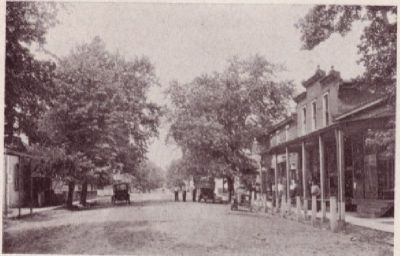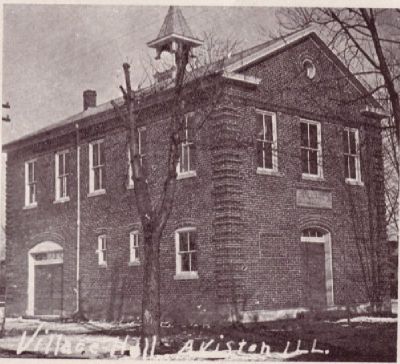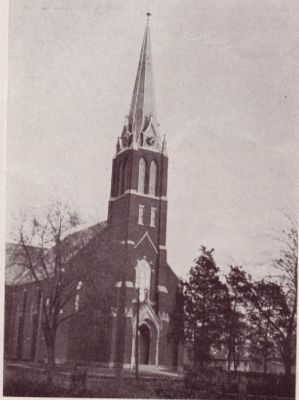THE CHRONICLE OF AVISTON
The original town of Aviston was situated on the old State Road, about one-half mile north of the present Village of Aviston, in the vicinity of the present farm of Mr. John Heimann. It was the first town in Sugar Creek Township to be established. "Old" Aviston was laid out in lots on April 29, 1836 by Alexander Shields. The town consisted of thirty-two lots and a public square. Mr. Shields opened a dry goods store and helped to establish a post office. Mail was received three times a week by stage coaches traveling on the old State Road.
"Old" Aviston was named after John T. Avis, a gunsmith. Mr. Avis stopped at Hull Stage Station on the old State Road, one-half mile north of the present Village of Aviston. He liked the area and stayed. A gunsmith shop was opened and Mr. Avis lived in the town named for him for many years until he moved to St. Louis, Missouri. He never returned to Aviston. Mr. Avis was the first man to open a business in the area and this is the reason given for the naming of the Village of Aviston.
Before the original settlement was abandoned, the village consisted of three stores, a post office, a hotel with a stage stand, a blacksmith shop, and about six private homes. Growth of the tiny village was halted completely when the O and M Railroad came through the area in the middle 1850's and the town was missed. It subsequently died completely and eventually reverted back to farm land. Nothing remains at the present time except the old graveyard on the farm residence of Mr. Oscar Stroot.
After the O and M Railroad came through Clinton County the people in the area of "Old" Aviston decided to relocate the settlement to be near the railroad. Consequently in 1860, Samuel Hull, who owned farmland on both sides of the railroad, sold a tract of land north of the railroad and west of Clinton Avenue (Aviston-Albers Road) to John W. Dugger and Company. This tract of land was originally called Hecker. The Dugger Company laid out eight blocks with ten lots in each block. Each lot was fifty feet by one hundred and twenty feet. Only one house was ever built in the tract however. It was put up on lot ten block eight. The Dugger Company further bought eighty acres from Samuel Hull. This tract of land was divided and marked off in lots and called Hull. Some time during 1860 the post office from "Old" Aviston was brought down to Hull. Rather than change the name on the post office, which was Aviston, the people changed the name of the town from Hull to Aviston. After a hundred years this seems to be the most logical and accurate reason for changing the name.
The post office from "Old" Aviston was relocated in Aviston about 1860. It was placed on the north end of lot one in block fourteen of the original town of Hull. Mr. Herman Friederich used the three room building many years for a combination post office, drug store, and residence.
Later on, the post office building was used as a warehouse by C. A. Stroot. In 1936 this building was sold to Mr. Fred Rohling. Mr. Rohling enlarged the original building and set up a tavern, a second floor was added to serve as living quarters for the Rohling family. The two story structure was sold to Mr. Julius Schoendienst in 1951. The business was operated by Mr. Paul Brueggemann for about a year in 1962. Mr. Ray Foppe bought the business in 1962. He and his family occupy the living quarters and operate the tavern at the present time.
Attempts to incorporate the Village of Aviston go back to January 20, 1874. A petition, drawn up by Herman Friedrich, was presented to the county court of Judge A. H. White. A general election of the people, concerning this incorporation, was then held on February 10, 1874, at the home of H. H. Heimann in Hull, Illinois. The judges of the election were Henry Dillmann, James J. McAlilly, and Herman H. Heimann. The vote to incorporate the Village of Aviston was 58 for and 7 against incorporation.
For some reason the results of the election for incorporation were not reported to the County Judge. There is no further record in this matter until 1879. At a village election in 1879 a police magistrate was elected. In a letter dated May 3, 1879, the Illinois Secretary of State informed the village leaders that the Governor had refused to issue a commission for the office of police magistrate until the evidence of incorporation of the Village of Aviston had been filed in the office of the Secretary of State.
Again, in 1884 a police magistrate was elected. His commission was again denied by state authorities until the incorporation of the village was complete. Finally on April 21, 1884, Mr. H. W. A. Friedrich was appointed by the Village Board to make a complete examination of the records.
Mr. Friedrich's report was given on May 5, 1884. The records proved that a petition had been received, an election held, and the votes counted. This is all that could be found. The original petition, which showed the location and boundaries of the proposed village, had failed to be recorded and was missing. The original petition was never found.
On April 30, 1884 Mr. Friedrich was given permission by the Village Board to institute proceedings in the county court to correct any omission of matters pertaining to the incorporation of the village. A new supplemental petition was drawn up and presented to the county court on May 6, 1884.
The case for incorporation of the Village of Aviston was heard in the courthouse at Carlyle by Judge A. H. White. All the documents and records necessary for the incorporation of the village were turned over to the court and accepted. Court records pertaining to this matter were ordered amended, and the incorporation of the Village of Aviston was approved. This was May 23, 1884. The boundary lines at that time included the original Hull plot, the Twiss Addition, and the town of Hecker. The certificate of recognition of the incorporation of the Village of Aviston was filed and recorded on October 24, 1884.
The village board in a meeting on January 3, 1887 adopted the first ordinances passed in the village. At this meeting the streets were named. In some cases the new streets were named, in others the old names in the original village of Hull were reaffirmed, and in others the names of streets were extended into areas of Hecker and the Twiss Addition.
Other ordinances passed at this time are very interesting. All able bodied men between 21 and 50 years of age had to work two days a year on the public streets. A man could get out of this labor by paying $.75 for each day.
The calaboose was established as a result of the twelfth ordinance passed at this meeting. It was located on the site now occupied by the village fire department. If a person was confined in the local calaboose he could work his fine out at whatever task the village officials designated. The prisoner received $.50 for an eight hour day. The sum was then subtracted from his total fine. While the prisoner was working on the village streets, he was to wear a ball and chain. The iron ball that was used is still in existence. The calaboose was burned down by Clarence Hull in 1902.
In 1888 kerosene street lamps were installed on the streets of the village. Also in 1888 and 1889 the first sidewalks were laid. These were made of wooden boards and some were cinders. The Bedford stone sidewalks were first laid in 1906.
A special meeting of the Village Board on November 8, 1906, granted a franchise to the Citizens Telephone and Telegraph Company to install poles and lines for telephone service.
At a meeting of the Village Board on April 1, 1907, bids by local merchants to build a new village hull were accepted. The bids were:
| Mrs. E. Dillmann, Lumber, Cement, Macadam . | $1280.00 |
| Hy. Dieker, cut stone ....................................... | 178.00 |
| Hy. Schmuck, concrete work, cement & plaster | 575.00 |
| B. J. Lager, Hardware ..................................... | 37.55 |
| G. Brefeld, Sheet metal and work .................... | 220.00 |
| Total ............................................................... | $2311.55 |
The present Village Hall was then built sometime during 1907. All local labor and merchandise from Aviston businesses were used.
A steel lattice cell for two prisoners was made in the Village Hall in 1907. It was made of one and one-half inch strips of steel. It was equipped with folding bunks on the wall. It was located on the first floor. The cost of the cell was $98.16. It was finally taken out in 1945.
The first Volunteer Fire Company Number One was organized in May 1909. Mr. Henry Lampe was the first president of the Aviston fire department. He maintained this position until his death in 1957. The present Aviston Fire District dates from December 15, 1950. On February 14, 1951, a bond election was passed, it authorized the raising of $15.000 to supply the needs of the district. A 1950 Ford fire truck was purchased for $2,887.35. The district also spent $8,720.000 for equipment. A new building was begun on March 30, 1951, to house the new truck and equipment. A second truck was purchased in 1956. The district has taken in the area around St. Rose. There was a 1958 Chevrolet fire truck, a booster tank, and a pump placed by the Aviston Fire District in St. Rose on April 4, 1962.
The village bought crushed rock to spread on the streets for the first time in June 1917. In May 1918 the first oil to be spread onto the streets was purchased.
The electric street lights were put into service in the village in November 1920. Electricity was also available for home use if desired.
The Village Water Works and elevated storage tank was built in 1950. Fred Luth and Sons were the general contractors. The original cost was $62,000. The cost was paid in this way: $22,000 in water revenue bonds, $20,000 in general obligation bonds, $10,000 donated by the Huber Slipper Company, and the remainder, $10,000, was paid by selling moral obligation bonds. These bonds were paid for by donations, town picnics, and various other socials.
When the water works was first established there were 90 original users. At the present time there are more than 200 homes and businesses using the water. The original hook-up fee was $10.00 and the monthly minimum was $2.00 per month. At the present time the hook-up fee for water is $50.00.
An iron removal and aeration plant was added to the water plant in 1957 at a cost of $11,095.00. The plant storage building and reservoir wits constructed by Aviston Lumber Company at a cost of $5200.00 The equipment for the iron removal and aeration was installed by the F. S. Crook Company of St. Louis, Missouri, at a cost of $5895.00. This improvement to the city water works was paid for by monies set aside by the village board from refunds of sales tax. With the addition of this equipment the community now has one of the finest water supplies in the state.
In May 1958 a modern garbage pickup service was offered to the people of Aviston. Modern Utilities Incorporated from Belleville, Illinois, perform this service.
A sewer system and treatment plant was built throughout the village in 1959. The general contractor was John J. Keeley Company from East St. Louis, Illinois. The original cost was $161,500.00. This money is being paid off in the following ways: $32,000 by obligation bonds, $100,000 in sewer and water revenue bonds, and $29,500 in the form of a Federal grant. There were 150 original users; the number has now grown to over 200. The hook-up fee is $50.00 and the monthly fee is $3.00.
In 1961 natural gas pipes were placed throughout Aviston and service was made available in September of that year.
PRESIDENTS OF THE VILLAGE BOARD
| Henry Rosen | **1880-1884 |
| Henry Daniel | 1884-1888 |
| August Peek | 1888-1892 |
| Henry Marks | 1892-1893 |
| H. W. A. Friedrich | 1893-1896 |
| Herman Lipsmeier | 1896-1897 |
| J. George Kues | 1897-1898 |
| G. J. Geers | 1898-1899 |
| Henry J. Holtkamp | 1899-1901 |
| Dr. F. G. Kuhls, M. D | 1901-1902 |
| Henry Ficker | 1902-1905 |
| Dr. C. E. Hill, M. D. | 1905-1909 |
| John A. Lampe | 1909-1913 |
| Fred G. Brefeld | 1913-1945 |
| John Bingamann | 1945-1952 |
| Fred Lohman | 1952- |
**-Village records previous to 1880 are missing.
These Have Served:
PASTORS OF ST. FRANCIS CHURCH
| Rev. Henry Boeker | October 2, 1865 |
| (Died November 23, 1874) | |
| Rev. Longinus Quitter, Ass't. Pastor | Left Sept. 8, 1875 |
| Rev. Frederich Lohmann | March 23, 1876 |
| (Died February 10, 1917) | |
| Rev. Anthony Kuhls | *1917 |
| (Temporary Administrator) | |
| Rev. Albion Breinlinger | *June, 1917 |
| (Retired *Fall, 1925) | |
| Rev. James Gillen | *Fall, 1925 |
| (Died June 20, 1932) | |
| Rev. George Lohmann | June 23, 1932 |
| (Resigned July, 1958) | |
| Rev. Jerome Feldmann | June, 1958 to Present |
| (Assistant Pastor) | |
| Rev. Cletus J. Cunningham | July, 1958 to Present |
| (Temporary Administrator) | |
• Approximate dates; accurate records were not made available.



